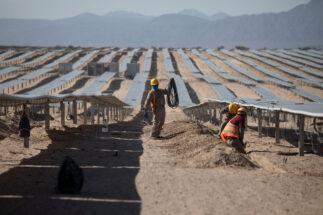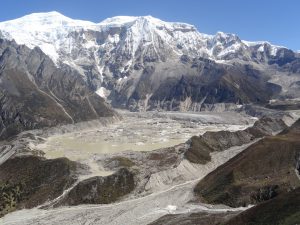Muzaffar Ahangar was one of many to receive a notice from Kashmir’s Irrigation and Flood Control (IFC) department. Ahangar lives in Kursu, a village along the Jhelum river in the district of Srinagar, in the Indian union territory of Jammu and Kashmir. The notice says, “Since your illegal structure figures in the list of encroachers on left side of River Jhelum [it] is to be removed. As such you are once again directed to remove your illegal structure within 5 days yourself, failing which your illegal structure would be dismantled and removed at your risk and cost.”
The department has compiled a list of over 1,000 people it says have built illegal residential and commercial structures on the banks of the Jhelum in Srinagar. Department officials said the total number of encroachers is over 2,500 in Srinagar and that the process of compiling the list is ongoing. They also said that there are just a few hundred encroachers in other districts – Baramullah, Bandipora, Pulwama and Anantnag.
Ahangar’s structure has not been dismantled, although it has been over a week since the notice was issued. The people who received notices have been given a chance to prove their case legally, and they may prevail. Some have managed to “legalise” their construction by receiving documents such as “No Objection Certificates” from the IFC department itself.
This points to a central contradiction of the anti-encroachment drive: the government itself is responsible for many encroachments. Dozens of structures and institutional facilities – which include rubbish dumps, public health institutes, panchayat (locally elected village governments) buildings and schools – have been built by the government on or near the banks of the Jhelum and its tributaries from south to north Kashmir. For example, solid waste dumping sites in Baramullah, Kupwara, Kulgam and many other towns are on the banks of the Jhelum or its tributaries.
Saleem Beg, regional head of non-profit the Indian National Trust for Art and Cultural Heritage (INTACH) in Jammu and Kashmir, said that Srinagar’s masterplan acknowledges many parts of the city as highly vulnerable to natural disasters, “yet, contradictorily, gives proposals like shifting the civil secretariat to Nowgam railway station which, as per the plan, is a highly flood-prone area and a designated flood-absorption basin.”
In recent years, the government has created institutional infrastructure on the flood plains of Bemina in Srinagar. These include a branch of the SKIMS (Sher-i-Kashmir Institute of Medical Sciences) hospital, a maternity hospital, the Srinagar Development Authority and a number of other government offices and government housing.
Successive governments have focussed primarily on the city of Srinagar in creating institutional facilities like hospitals and main government offices. “The government’s urbanisation policy is such that Srinagar city bears the brunt of all the population. With the main government offices as well as health and education institutions located in Srinagar, people prefer to live in Srinagar only,” said Mohammad Sultan Bhat of the University of Kashmir’s geography department. “This is why land became scarcer in Srinagar and creation of infrastructure was even allowed in floodplains.”
Referring to the removal of encroachments, Saleem Beg of INTACH said that other issues need to be dealt with far more urgently. “Let me put it this way: if we have 10 challenges while dealing with floods, encroachments are the 10th challenge. There are nine others which need to be prioritised before removing encroachments. Dealing with water budgeting is of primary importance. For that, catchment treatment is the key.”
Beg said the problem of flooding does not start with the Kashmir valley’s main river (Jhelum), but with the catchments which supply water to the river. “So, the problem of flooding has to be dealt with in the catchments of the main river. Fortunately, we have 17 catchments which feed the river Jhelum. If we are able to retain and delay the flow of water from there by treating the catchments, the problem of flooding will be solved to a larger extent. But the problems in the catchments are not being considered.” Every time the problem of floods is discussed, engineers are told to focus on the Jhelum Beg said, adding, “What will the poor fellows do in Jhelum when the problem lies somewhere else?”
After the devastating floods in Kashmir in 2014, the government managed to remove over 300,000 trees and 700 structures from encroached areas of the Jhelum in a demolition drive. But environmentalists say the government needs to deal with all the problems facing Kashmir’s rivers, including its own problematic policies.
“It is good if encroachments are being removed from the river Jhelum’s banks, but the government should look into all the aspects which determine the overall health of the river,” said Raja Muzaffar, an RTI (right to information) and environmental activist. “Let me quote the example of proposed massive mining in the river Jhelum and the streams which flow into it. Many experts have cautioned that it is extremely dangerous. But the process for this is still on under official supervision. It shows the non-seriousness towards environmental issues.”
Warning from experts
Experts have said that any mining (in the Jhelum and its tributaries) has to be done in a way that does not cause problems in flood management or the functionality of water bodies. An engineer from the IFC department, who requested anonymity because he is not authorised to speak to the media, said that intensive mining in the Jhelum and its tributaries will increase the possibility of floods manifold. “Earlier, we used to face the flood situation if it rained incessantly for two days or more; now a few hours will be enough in the future to cause floods,” he said.
The 2014 floods cost hundreds of lives and millions of dollars in Kashmir, and downstream in Pakistan. Almost every year the administration in Kashmir spends time, energy and resources dealing with floods and people panic whenever rivers start to swell.
“We know we will be blamed when the floods strike, but the fact is we are not at fault. Our department is under tremendous pressure from the authorities who ask us not to raise any queries during the process of clearance for mining projects,” the engineer from IFC said.
The controversial auctioning of mining rights in the riverbeds and streambeds of Jammu and Kashmir, creating land banks for industries or easing rules for security forces to construct in strategic zones have all provoked criticism.
Saqib Qadri, convener of the Srinagar-based Peoples’ Environmental Council (PEC), said, “The environmental challenges need to be looked into holistically.” Any conservation or flood management work, he said, will not work unless effective measures are taken to deal with all the issues.
“As regards the mining of minerals, it should be strictly done as per the guidance of environmental laws. Any activity in our region, which is ecologically very sensitive, has to be environmentally sustainable,” Qadri said.
These issues continue to be ignored. On August 18 this year, the Jammu and Kashmir government issued a notification authorising panchayats to carry out mining operations in up to one hectare area of riverbeds across the region.
“The government may allow the Department of Geology and Mining to apply for and secure clearance like mining plans, environmental clearance and consent to operate from the competent authorities on behalf of the panchayats to be transferred to them later on,” reads part of the notification, which adds that this process will be applicable until September 30, 2021. Meanwhile, the process for issuing environmental clearances to the successful bidders for hundreds of mining blocks in Jammu and Kashmir, including the Jhelum river, is going on. “It is most likely that the majority of them will get clearances given the pressure from higher-ups,” said an official.
Citing the “acute and unprecedented shortage of key material for development works and challenging Covid-19 pandemic”, on July 30, 2020 the Jammu and Kashmir government issued an order for the “fast-tracking of environmental clearance process” for riverbed mining operations.
Hundreds of mineral blocks in the Jhelum and its tributaries (which include sand, boulders and gravel) have been auctioned for five years to contractors and companies by Jammu and Kashmir’s Department of Geology and Mining. This year, applications for the auctioning process were invited online from outside Jammu and Kashmir following New Delhi’s decision to scrap the semi-autonomous status of the region on August 5, 2019, which had previously restricted these rights to local residents. This year, most of the mineral blocks auctioned have been bought by companies based outside Jammu and Kashmir.
In a meeting in December last year Jammu and Kashmir Environmental Appraisal Committee, an officially recognised body, advised the government that no mining should be allowed in the Jhelum and other rivers until there is a basin-wise scientific mining plan. “It should not be done in a hotchpotch manner,” the committee had advised.
![<p>The Jhelum river flows through the district of Srinagar, its floodplains choked with official and unofficial encroachments [Image by: Athar Parvaiz]</p>](https://dialogue.earth/content/uploads/2020/08/Jhelum-flowing-through-Srinagar-image-by-Athar-Parvaiz.jpg)








